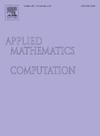衰减锥形拉顿变换的反演公式:平面和圆柱体情况
IF 3.5
2区 数学
Q1 MATHEMATICS, APPLIED
引用次数: 0
摘要
自康普顿相机成像发明以来,人们对锥形拉顿变换进行了深入研究。锥形拉顿变换将定义在三维欧几里得空间上的给定函数映射为其在锥面上的曲面积分。从非限制性圆锥拉顿变换中恢复这样一个函数的问题是一个过度确定的问题,因为所有圆锥的集合取决于顶点的三个维度、中心轴的两个维度和一维开口角。因此,人们也研究了各种类型的受限圆锥拉顿变换。然而,这些研究大多忽略了介质的衰减。本文研究了三维空间中顶点位于平面(称为平面情况)或圆柱体(称为圆柱体情况)上的衰减锥形 Radon 变换。在所有情况下,函数都是在圆锥面上积分,附加权重随到圆锥顶点的距离减小而减小。主要结果为平面和圆柱体情况下的衰减圆锥拉顿变换提供了明确的反演公式。本文章由计算机程序翻译,如有差异,请以英文原文为准。
Inversion formulas for the attenuated conical Radon transform: Plane and cylinder case
Since the invention of Compton camera imaging, the conical Radon transform, which maps a given function defined on 3-dimensional Euclidean space to its surface integrals over cones, has been studied intensively. The problem of recovering such a function from its unrestricted conical Radon transform is overdetermined, since the set of all cones depends on the three dimensions of the vertex, the two dimensions of the central axis, and the one-dimensional opening angle. Therefore, various types of restricted conical Radon transforms have also been studied. However, most of these studies have neglected the attenuation of the medium. This article presents the study of attenuated conical Radon transforms with vertices on a plane (referred to as the plane case) or the cylinder (referred to as the cylinder case) in a 3-dimensional space. In all cases, the function is integrated over conical surfaces with an additional weight that decreases with the distance to the vertex of the cones. The main results provide explicit inversion formulas for the attenuated conical Radon transform in the plane and in the cylinder case.
求助全文
通过发布文献求助,成功后即可免费获取论文全文。
去求助
来源期刊
CiteScore
7.90
自引率
10.00%
发文量
755
审稿时长
36 days
期刊介绍:
Applied Mathematics and Computation addresses work at the interface between applied mathematics, numerical computation, and applications of systems – oriented ideas to the physical, biological, social, and behavioral sciences, and emphasizes papers of a computational nature focusing on new algorithms, their analysis and numerical results.
In addition to presenting research papers, Applied Mathematics and Computation publishes review articles and single–topics issues.

 求助内容:
求助内容: 应助结果提醒方式:
应助结果提醒方式:


